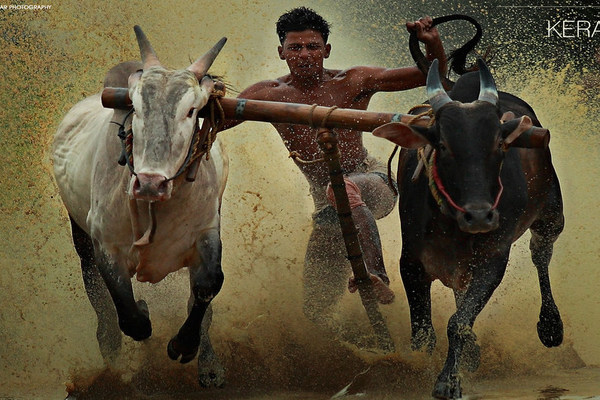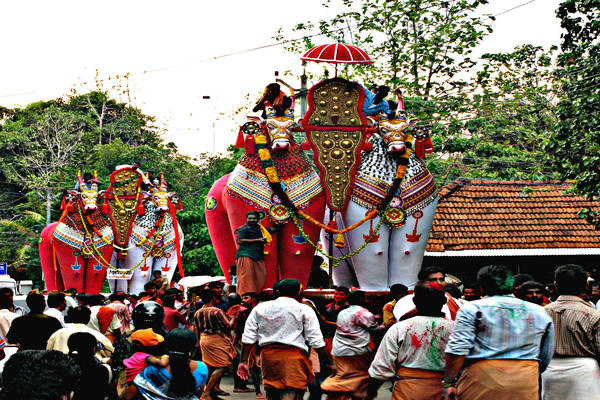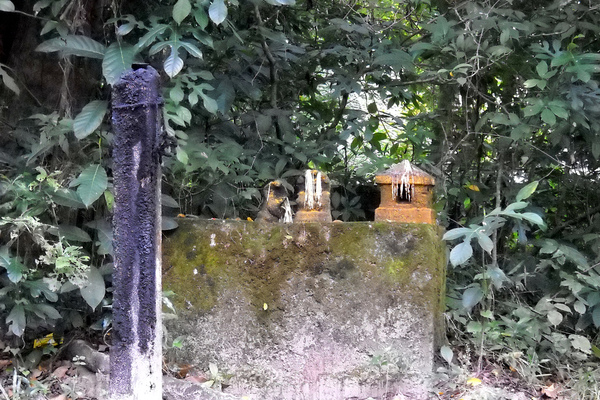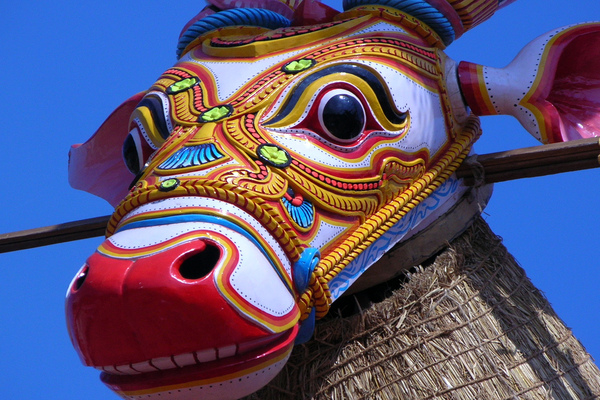12/05/2017
They came in hundreds. Each “kara” pulling their chariot mounted with gargantuan forms of bulls, the draught animals they depended on to tear open their fertile loams and sow their seeds of hope and prosperity. Hundreds of sweating bodies, unmindful of the sweltering heat of the sun at its zenith in “Meenam,” their brazen shoulders and their might at the wheels of their chariots, heaving their gigantic offerings to the courtyard of their benevolent benefactor, seeking her blessings for a bountiful year ahead. The temple deity is most often Mother Kali in her different moods as devi, durga, amma, thamburatti or the fear inspiring Bhadrakali.
The bulls were perfect in their symmetry and each pair etched a sharp contrast in their pure white and crimson garb, above the teeming multitude accompanying them. Their heads were painted intricately highlighting their rolled out eyes. Garlands of several small bells adorned their graceful necks. Pair after pair, from all directions, the chariots bearing the bulls trundled down the mud-beaten village paths and converged upon the temple grounds, accompanied by thumping drums and surrounded by a cheering crowd.
This is my fanciful interpretation of the famed “kettukazhcha” of the Onattukara tract of Kerala (derived from Onam Oottu Kara meaning granary): a narrow strip of land sandwiched between the coastal sands and the rolling hills of the miduplands, between Chengannur and Karunagapally. This strip is unique with its greyish sandy soils, numerous streams associated with the backwaters of Kayamkulam & Ashtamudi, ancient “sarpakaavus” and a rich agrarian past in which paddy, sesamum and tuber crops like colocasia, elephant foot yam, dioscorea and tapioca featured prominently. Morning breakfast in most homes here would be an assorted platter of plain boiled chunks of these tubers accompanied by a piping hot sauce made by grinding coconut and birds-eye chillies popularly called “kaanthari chammandi,” or the ever present “aval” (steamed and pounded rice) mixed with jaggery and coconut.
It is also a land seeped in its age old traditions that are inexorably linked to its once prosperous farming systems and practices. Hence it’s small wonder that this tract be known all over for its “thazha” products, maramadi malsarams, and the “kettukazhchas.” Thazha refers to the dried leaves of screw pine or “kaitha” found abundantly along the banks of innumerable streams in this region from which local women weaved out a wide range of mats, each with its own exclusive use, mostly associated with the farming practices of the region: “thazhapaya” “methapaaya” “panamb”… so on the list goes. “Maramadi malsarams” refer to the practice of racing bulls specifically trained for this activity in the freshly puddled clayey paddy fields as part of a competition that can again be traced back to the long standing tradition embroiled in agriculture.
My ancestral roots have no moorings in this land, but as a young bride I was introduced to this totally different world from my own, twenty-five odd years ago. In my husband’s home I got acquainted with Chella, a native of Thazhava (centre of origin of all “thazha” products) who my mother-in-law assured me no one from miles around could beat at in her skills in harvesting paddy. I could very well picture this tall robust woman with her splendid, polished, dark, glistening body, lips all red and moist from the “paan” constantly tucked securely somewhere between her molars and right cheek, with a sonorous voice commanding a group of women and goading them to the limits of their potential. I was always in awe of her and I couldn’t imagine anyone summing up enough courage to stand up against her. Prior to her marriage into my husband’s homeland, she was an expert screw pine mat weaver. She continued to be the family’s chief “farm woman” till the time my father-in-law became too old to pursue the traditional farming. The sons decided to shift to the tamer rubber cultivation and sold off all those paddy lands, later on, only after their father’s demise.
My introduction to the famed racing bulls came through my husband’s uncle. He was a bachelor. I recall vividly a tale my husband once told me about his uncle’s amorous intrigue. It was a colored love story in cinema style, in which the two unrequited lovers vowed to stay single till their death! Notwithstanding this past disastrous liaison of his, I discovered, he had already found his second love, if not in the feminine form of either human or animal, but in the form of the ultimate symbol of masculine virility and dominance, the bull. Seeing the wide eyed interest upon my face when he waxed eloquent about his bulls, which had by then earned him several trophies in the “maramadi malsarams,” he invited the newlyweds to see his precious possessions. I was expecting to see a huge pair, my visions being fired by the images of those European giants and my very few, distant encounters of the stall bred local ones. I was quite piqued to see a lean medium-sized pair completely at odds with my imagination, until my eyes locked on their faces. Their eyes contained their fierceness and their sharp, pointed horns send silent shudders down my spine. We were warned to keep a safe distance from them, for they were highly temperamental and would sometimes react violently to strangers. But our uncle was all fatherly love in its most benign form. Though our uncle didn’t keep a household for his own purpose (he always had his food at our father’s sister.) he had two cooks, two helps and two trainers to take care of his darlings. Recently through the intervention of animal lovers the “maramadi malsarams” have been banned owing to the cruelty meted out towards these animals. From what I’ve seen, these bulls were in no ways tortured, on the other hand, pampered to the extreme till the “D” day. But it is true that on the day of the competitions they were fed with local toddy and in their excited state were goaded on with whip lashes, to make them take circuitous paths around the soggy clay fields with a manic spurt of energy as commanded by their jockeys. I wonder whether those animals felt the pain or whether they were in a sense, relieved at letting loose all that pent-up energy built up through months of attentive rearing.
The “kettukazhchas” were a sight no one could forget in a hurry. It is the culmination of a weeklong festival and every one from miles around gather at the temple to witness the massive effigies rolling out into the vast temple grounds. Agreed, it’s hot, noisy, the crowd boisterous and you have to be careful of drunken men acting in a stupor. You also have to beware of chain snatchers and pick pockets and be prepared at being jostled about. But it is worth taking a risk at odd intervals. It helps one connect to her cultural roots. It makes one think of the logic behind such customs and their significance meriting such rich glorification. It makes one swell with pride at the laudable legacy.
But it also fills one’s mind with sadness when one realize that the very basis of such cultural fanfare have eroded beyond redemption now. For me, it pricks my conscience when I think that I have distanced my son from such enjoyments through his grooming, so much so that the next generation finds no pleasure out of these rituals they consider too pagan or crude to observe.
Be it so, the “kettukazhchas” roll out, year after year, each year surpassing the one before in its opulence and fervour. But the community that foster these have long lost the need of the blessings of their Goddess for any agricultural prosperity whatsoever. The once fertile plains with its rich diversity of crops have become a thing of past, and there are no bulls anywhere in the landscape toiling along with their masters to reap the bounty offered by a nubile earth. Hence these festivals become mimes of a hoary past and every person who partakes becomes a clownish figure making a mockery of his own decline. The boosted pomp and gaiety have become vain and redundant in their intent.
Photo credit: spisharam via Foter.com / CC BY -Reji via Foter.com / CC BY-NC-SA
sreeramnambiar via Foter.com / CC BY-SA Neo-grapher via Foter.com / CC BY




